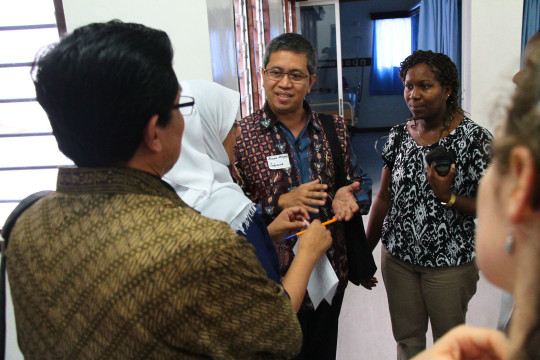Strength in Numbers: The Power Behind Peer Learning Networks
By Tracy Romoser, Communications Officer, PATH
Mar 16, 2015
Posted in BID Learning Network (BLN), People
The BID Initiative is designed with an embedded peer learning network, the BID Learning Network (BLN). Through this peer support and collaboration, participants are able to learn from the successes and failures in other countries, and build new solutions together so they can make faster progress than they can alone. Participants have already and continue to share personal experiences, providing invaluable insight to the BID Initiative efforts and other BLN participants through our Google Group discussions, webinars and in-person consultation meetings. The following post on the value of peer networks originally appeared on the PATH blog.

Photo: PATH.
Around the world, a large percentage of the global health community still records data and tracks medical inventories by hand using paper forms. Yet by studying India and Thailand’s health insurance information systems, Ghana and Kenya were able to develop their own e-claims standard and automate their payment processes.
As technological advances make accessing and sharing data a practical activity, it’s easy to lose sight of how effective it is to simply ask someone to share their lessons and what’s worked for them.

Photo: Flickr/Maker Faire Africa.
When people cross borders to collaborate with their peers in other countries, the result can be new and novel approaches, models, and examples of implementation. Photo: Flickr/Maker Faire Africa.
Today, this type of sharing reflects a paradigm shift in global health programs as we see the development of national experts who can connect emergent experiences.
Sometimes, the best solutions have a deceptively simple approach
It’s called peer-to-peer learning. And through this model, a fresh set of voices and views are creating effective solutions to global health challenges from the ground up.
Peer-to-peer working groups are made up of those leading the way at the national level. Medical practitioners, health officials, service engineers, purchasing decision-makers, and others—all of whom come together across borders to share their knowledge and find common solutions, together.
Joint Learning Network: a global health network for sharing knowledge
The Joint Learning Network (JLN) is one example of how an innovative country-led program can achieve success through the power of knowledge exchange among peers.
In this video, JLN Information Technology (IT) track members work together to determine and document common requirements for IT systems that support national health insurance information scenarios. Video: JLN.
By removing the silos that policy makers and practitioners often operate in and offering opportunities to share their successes, even failures, JLN members are finding innovative solutions that can be put to work more quickly than those developed through more traditional channels.
Sam Adjei, executive director at the Centre for Health and Social Services Ltd in Ghana, gives this example:
“We had to do things on our own, learning by doing. But when we start connecting with people and we start diving into details of how to do things—enrollment, registration, IT, provider payment—then it’s critical to have this exchange with other people and get to know how did they do it.”
This is how Ghana and Kenya were able to take their new e-claims systems a step further and make them available for other countries to use.
PATH’s role as a trusted matchmaker
PATH helps to match participants across countries who can share knowledge, analyze user needs and requirements, and use this new information as a tool to develop and iterate solutions in their own countries.
One of the greatest challenges in forming peer networks is making sure participants receive executive support for their work. This covers everything from supporting volunteer participants as they take time away to attend learning groups, to the investment they’ll need to implement new programs and systems.
“We ask countries to support these collaborative cross-country teams,” says Kate Wilson, director of Digital Health Services at PATH and one of the founding members of the JLN IT group. “People are busy. And the participants who are most driven to make change need permission to invest the time it takes to learn what made other projects successful and apply that knowledge at home.”
Wilson highlights another example of bringing efficiencies to country-wide health systems: the Better Immunization Data (BID) Initiative. Supported by a grant from the Bill & Melinda Gates Foundation, the BID Initiative was developed to help countries strengthen their immunization programs through improved data quality, collection, and use by identifying practical, country-owned, country-led digital health solutions.
“There’s power in bringing countries together to design solutions, see them implemented in a few places, and then take it and adapt it to their own situation,” says Wilson. “Like the new e-claims systems in Ghana and Kenya, we expect that members of the BID Learning Network will design the standards and solutions that will be used for generations to deliver lifesaving impact.”
